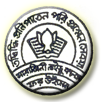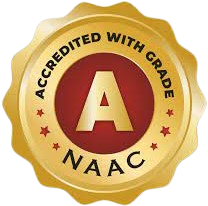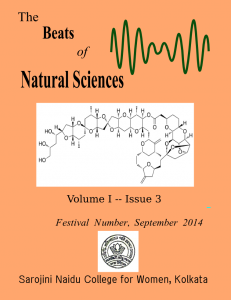ISSN 2348 – 7615
Volume I, Issue 3 Festival Number (September), 2014
From the Desk of the Editors:
The third issue of this quarterly journal has now been published. The journal, even within this short period of time, is gaining attention within the academicians and researchers of different disciplines of natural sciences. Contributions from different areas are being submitted to this journal at regular intervals. But in this issue we selected to publish only five articles due to different technical reasons. Though the online submission system of journal still occasionally develops certain technical glitches, the main obstacles behind not being able to select some interesting articles for this issue are the absence of proper reference lists in the submission, too technical presentations of the articles for the mixed audience of a journal of interdisciplinary nature like the current one, etc. But we hope to publish those articles too in the coming issues after necessary revisions from the corresponding authors.
After these three issues, it may be apparent that the primary purpose for the publication of this journal has already been met. This journal is really developing into an effective vehicle of academic exchanges among the college teachers of natural sciences along with the scientists working in different institutes, at least within our state; the list of authors in these issues itself may substantiate that claim. Moreover the interdisciplinary character of this journal is also obvious from each of these issues. But the bilingual character of this journal has somewhat been …
Download pdf: From the Desk of the Editors
Brief reports of original research works:
- Hydrogenated Nanocrystalline Silicon (nc-Si:H) Solar Cell
Romyani Goswami [dropdown_box expand_text=”Abstract” show_more=”View” show_less=”Hide” start=”hide”]Hydrogenated nanocrystalline silicon (nc-Si:H) thin films have been deposited at different power by radio frequency plasma enhanced chemical vapor deposition (RF PECVD) technique. Single junction solar cells have been fabricated with nanocrystalline Si as absorber layer. The solar cell performances have been studied by varying i-layer thicknesses. The optimized solar cells show less than 1% degradation upto 50 hours of light soaking. Then the cells degrade upto 500 hours and thereafter they become steady. Using nanocrystalline silicon as absorber layer the solar cell efficiency degrades maximum 9% before stabilisation.[/dropdown_box] Download Full Paper
Review on current frontiers or historical milestones:
- Nanotechnology in Cosmetics
Soma Gorai [dropdown_box expand_text=”Abstract” show_more=”View” show_less=”Hide” start=”hide”]Today nanotechnology is associated with almost every sector, from molecular biology to electronics or from textiles to food and beyond. In the cosmetics sector, this new trend has been extremely used by cosmetics manufacturers to improve their existing products and also to develop new ones. They use nanomaterials to provide better UV protection, deeper skin penetration, longer-lasting effects, increased color and finish quality etc. Inorganic nanoparticles like TiO2 and ZnO are used as UV filters in sunscreens. Except these, different types of encapsulation and delivery systems such as liposomes, niosomes, dendrimers, nanoemulsions, or solid lipid nanoparticles etc. are also used in cosmetics and personal care products. This review article provides some information about the types of nanomaterials used in the cosmetic products and also about the potential benefits and risks associated with their use. [/dropdown_box]Download Full Paper
- Recent Development of Vinca-domain Anticancer Drugs Binding to Tubulin
Lalita Das[dropdown_box expand_text=”Abstract” show_more=”View” show_less=”Hide” start=”hide”] Studies on vinca domain binding drugs were done in great details as they are recognized as a potential target for anticancer drug development. Their structures, properties, mode of action, success and failures have been discussed in short detail in this review. The toxicity level of these drugs towards the host cells and the extent of efflux of drugs by the P-glycoprotein mediated pump are also discussed. [/dropdown_box]Download Full Paper
Science, environment and society:
- Autism Spectrum Disorder (ASD): the enigmatic disorder that knows no boundaries
Mitu De [dropdown_box expand_text=”Abstract” show_more=”View” show_less=”Hide” start=”hide”]Autism Spectrum Disorder (ASD) is a global health crisis that knows no borders; it does not discriminate based on nationality, ethnicity or social status. ASD is a very complex neurological condition, most commonly appearing during the first three years of life. ASD affects the way a person’s brain and body works. It is not a disease and is not contagious. ASD is a lifelong developmental disability. Professionals diagnose ASD by the presence or absence of certain behaviours, characteristic symptoms and developmental delays. Early intervention therapy is the only documented way of managing ASD. So awareness of this disorder is of utmost need for early detection and subsequent early intervention.[/dropdown_box]Download Full Paper
- Developmental stages of Hemerobius indicus Kimmins (Hemerobiidae: Neuroptera) from western Himalaya, India
Santi Ranjan Dey[dropdown_box expand_text=”Abstract” show_more=”View” show_less=”Hide” start=”hide”] Hemerobius indicus Kimmins are very active foragers and predate upon the aphid Prociphilus himalayensis Chakrabarti infesting Lonicera sp in Western Himalaya. Developmental history of Hemerobius indicus Kimmins, an endemic aphidophagous hemerobid, was studied from Western Himalaya, India. The egg, larval, pupal developmental stages of Hemerobius indicus Kimmins were studied in detail. Oviposition, fecundity and longevity of the adult were noted along with their predatory efficiency. At low temperature (18 ± 1.9ºC) Hemerobius indicus Kimmins found to be a more efficient predator than other Hemerobiidae members.[/dropdown_box]Download Full Paper
Contact Informations :
| Publisher: Principal, SAROJINI NAIDU COLLEGE FOR WOMEN |
Address: SAROJINI NAIDU COLLEGE FOR WOMEN,30, Jessore Road, Dumdum, Kolkata 700028, India | Phone No.: +91-33-2559 2583 email: info@sncwgs.ac.in |
| Editors: Dr. Sonali Saha Dr.Soma Aditya Bandyopadhyay Dr. Chaitali Biswas |
Address: SAROJINI NAIDU COLLEGE FOR WOMEN,30, Jessore Road, Dumdum, Kolkata 700028, India | Phone No.: +91-33-2559 2583 email:editors.bns@sncwgs.ac.in |
 Pay Your Fees
Pay Your Fees 



